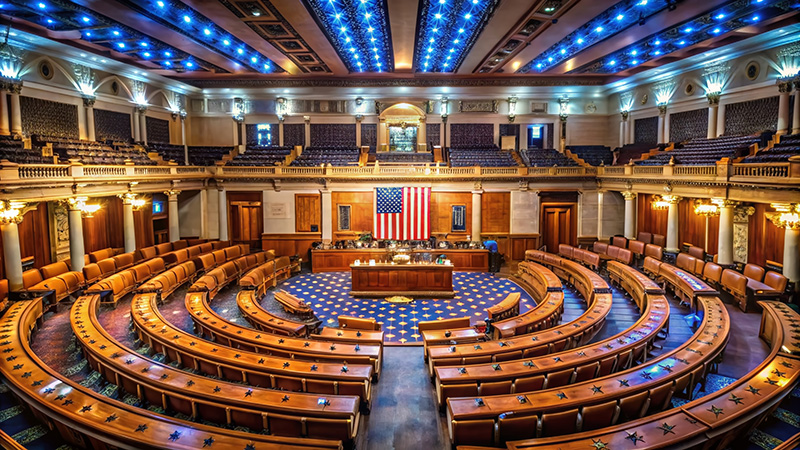Written by Kellen PA staff, the Capitol Compass is a monthly newsletter offered to clients as a Kellen product. Read the Special Edition Shutdown Showdown Update below.
Disclaimer: Many of the developments discussed below are fluid and may change rapidly. The information is relevant and accurate as of 9:00am EDT on October 1, 2025.
The federal government officially entered a shutdown at 12:01 a.m. EDT on October 1, 2025, after Congress failed to pass a funding measure to sustain operations into the new fiscal year.
- Scope of the shutdown
Most agencies that rely on annual appropriations have suspended non-essential operations. Some independent and statutorily funded entities (for example, the Consumer Financial Protection Bureau) continue limited operations because their funding is not tied to the annual budget process.
- Furloughs and unpaid essential work
Hundreds of thousands of federal employees are being furloughed, while essential personnel will continue working without pay. The Congressional Budget Office estimates the daily cost to the economy could reach approximately $400 million in lost wages and output.
- Health, science, and public health agencies
The Department of Health and Human Services expects to furlough roughly 41% of its workforce. At the Centers for Disease Control and Prevention, significant reductions in staffing will hamper communications, oversight, and surveillance. The National Institutes of Health anticipates suspending much of its research operations, peer-review processes, and grant reviews.
- Judiciary under strain
Although courts will still hear constitutional and critical cases, many court staff—including probation officers, clerks, and support personnel—may be furloughed. The judiciary warns it may not be able to sustain full operations past October 3 without additional funding or legislative action.
- Services that remain, and those disrupted
Core national security, law enforcement, and public safety functions continue, though often at reduced capacity. Programs like Social Security, Medicare, and Medicaid are not expected to be disrupted, though beneficiaries may face delays in ancillary services. Many public services, including national park operations, routine inspections, and grant-making, are largely suspended.
- Length of Last Shutdown
The last major U.S. government shutdown happened in 2018–2019, stretching 35 days from December 22, 2018, to January 25, 2019, making it the longest in U.S. history. That shutdown was triggered by a standoff over President Trump’s demand for $5.7 billion in funding for a border wall, which Democrats refused to approve as part of the spending bills. As pressure mounted, Trump relented and agreed to a stopgap funding bill, ending the shutdown.
- Length of Current Shutdown
Negotiations are ongoing but there’s no clear path yet: Republicans, though holding both chambers, couldn’t marshal the 60 Senate votes needed for a stopgap, while Democrats are pressing to pair funding with health-insurance subsidy extensions and reversal of recent Medicaid cuts, terms GOP leaders reject. Analysts split on timing: some expect a resolution within days to a couple of weeks, but given the policy stakes, including healthcare subsidies and structural agency changes, the shutdown could persist longer absent a compromise. In short, there is no consensus on length; it hinges on whether leadership can break the impasse soon.
Takeaway: The shutdown is now reality. Federal contractors, grantees, and state and local program partners should plan for immediate service interruptions, delay in reimbursements or payments, and ongoing uncertainty until Congress and the White House reach a resolution.

Federal Nominations
Senate Republicans finalized a rule change to accelerate the voting process for President Trump’s federal nominees. The Senate voted 51-44 to adopt a resolution allowing nominees to be considered in groups rather than individually. Currently, 150 nominees await floor consideration.
Senate Democrats argued the change undermines the Senate’s ‘advice and consent’ role, while Republicans contend Democrats intentionally slowed the nomination process.
Typically, the Senate requires unanimous consent to speed floor consideration, with any one Senator able to stall proceedings.
Takeaway: This change is expected to expedite confirmations and free Senate floor time for advancing legislation.
Special Elections
On September 9, a special election in Virginia’s 11th Congressional District was held to fill the vacancy left by Rep. Gerry Connolly (D-VA-11). James Walkinshaw (D) defeated Stewart Whitson (R) with 74.8% of the vote and was sworn in on September 10.
In Arizona’s 7th Congressional District, Pima County Supervisor Adelita Grijalva (D), daughter of former Representative Raul Grijalva, defeated Republican businessowner Daniel Buterez with 70.6% of the vote. She is expected to be sworn in on October 7, when the House returns from recess.
With these results, the House balance shifts to 219 Republicans and 214 Democrats.
Upcoming special elections:
- Texas’ 18th Congressional District – November 4, 2025
- Tennessee’s 7th Congressional District – December 2, 2025
Future Senate elections to note:
- Ohio Senate – November 3, 2026
- Florida Senate – November 3, 2026
Takeaway: These elections slightly tighten the House margin, while upcoming contests could further shape control heading into 2026.
Redistricting
Several states are considering redrawing their voting maps ahead of the 2026 midterm elections, including Texas, Missouri, Florida, Indiana, California, New York, Maryland, Illinois, Ohio, Louisiana, Wisconsin, and Utah.
States that pass new maps will likely face prolonged court challenges over validity and fairness.
Takeaway: Court battles over redistricting could delay candidate filings and impact the balance of power in 2026.


